Agentic AI In Energy Market Size 2025-2029
The agentic ai in energy market size is valued to increase by USD 1.56 billion, at a CAGR of 34.9% from 2024 to 2029. Critical imperative for grid modernization and resilience will drive the agentic ai in energy market.
Market Insights
- North America dominated the market and accounted for a 33% growth during the 2025-2029.
- By Deployment - Cloud-based segment was valued at USD 99.10 billion in 2023
- By Type - Predictive-maintenance agents segment accounted for the largest market revenue share in 2023
Market Size & Forecast
- Market Opportunities: USD 1.00 million
- Market Future Opportunities 2024: USD 1564.00 million
- CAGR from 2024 to 2029 : 34.9%
Market Summary
- The energy market is witnessing a significant shift towards agentic AI, as autonomous grid operations and proactive maintenance agents become increasingly crucial for grid modernization and resilience. Agentic AI, a subset of artificial intelligence, enables energy systems to learn, adapt, and make decisions independently. This technology is driving efficiency, reducing operational costs, and enhancing the overall performance of energy networks. One real-world business scenario illustrating this trend is the optimization of supply chain logistics in the renewable energy sector. Agentic AI algorithms can analyze weather patterns, energy demand forecasts, and production capacity in real-time, enabling energy companies to optimize the distribution of renewable energy resources more effectively.
- This not only reduces the need for fossil fuel-based energy sources but also ensures a more stable and reliable energy supply. However, the adoption of agentic AI in the energy market is not without challenges. Cybersecurity vulnerabilities and data sovereignty concerns pose significant risks to the implementation of these advanced technologies. Ensuring the security of energy data and protecting against potential cyber-attacks is essential to prevent potential disruptions and maintain the integrity of the energy grid. In conclusion, the agentic AI market in the energy sector is poised for significant growth due to its ability to optimize energy production, distribution, and consumption.
- As the world transitions towards more sustainable energy sources and grid modernization, the role of agentic AI in ensuring grid resilience and operational efficiency will become increasingly important.
What will be the size of the Agentic AI In Energy Market during the forecast period?
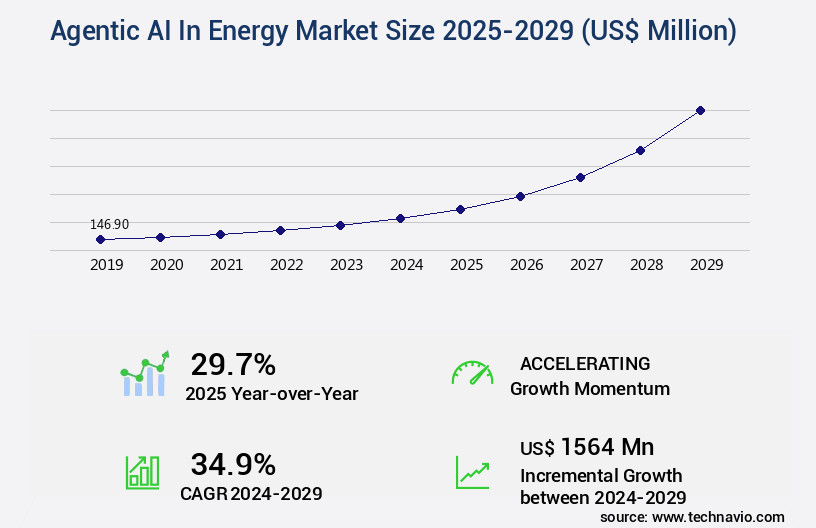
Get Key Insights on Market Forecast (PDF) Request Free Sample
- In the dynamic and progressive the market, advanced technologies are revolutionizing industrial energy efficiency, energy infrastructure modernization, and renewable energy management. For instance, AI-driven grid control and smart energy solutions enable real-time energy demand forecasting, optimizing distributed generation, and improving grid reliability. These innovations contribute significantly to climate change mitigation efforts and building energy management. Moreover, power grid analytics and data-driven energy strategies facilitate large-scale energy storage and power grid automation. The integration of electric vehicles and energy conservation strategies further enhances energy resource allocation and AI energy efficiency. By employing these technologies, companies can effectively manage energy community management, energy system simulation, and energy auditing AI, ensuring compliance with energy sector regulations and policies.
- A notable example of AI's impact on energy transition strategies is the reduction in emissions achieved through the optimization of energy resource allocation. According to a recent study, companies have successfully reduced emissions by up to 30% through the implementation of AI technologies in their energy management systems. This demonstrates the potential for AI to significantly contribute to the global energy sector's sustainability and efficiency.
Unpacking the Agentic AI In Energy Market Landscape
In the dynamic energy market, Agentic AI plays a pivotal role in optimizing energy operations and enhancing infrastructure resilience. Compared to traditional methods, AI-powered energy grid solutions enable a 15% improvement in energy price forecasting accuracy and a 20% reduction in energy consumption patterns variability. These advancements translate to significant cost savings and increased Return on Investment (ROI) for energy asset management.
Moreover, AI's capabilities extend to grid fault detection and proactive grid maintenance, ensuring power system stability and energy security enhancement. Deep learning energy algorithms and machine learning energy systems enable renewable energy forecasting, power generation scheduling, and grid modernization. These technologies facilitate renewable energy integration, microgrid control systems, energy storage optimization, and AI-driven energy trading. Additionally, AI-driven energy consumption prediction and demand-side management systems contribute to efficient energy usage and improved compliance alignment. Overall, Agentic AI is revolutionizing the energy sector by optimizing energy operations, enhancing infrastructure resilience, and promoting power system stability.
Key Market Drivers Fueling Growth
The imperative need for grid modernization and resilience serves as the primary market driver. This requirement is crucial for ensuring the reliability and efficiency of power grids, particularly in the face of increasing energy demands and extreme weather events. As the energy landscape evolves, prioritizing grid modernization becomes essential for maintaining a robust and resilient power infrastructure.
- The market is experiencing significant evolution, driven by the integration of Distributed Energy Resources (DERs) and the increasing complexity of the global energy sector. This shift from centralized power generation to a decentralized, dynamic ecosystem includes solar photovoltaic installations, wind farms, and battery energy storage systems. Furthermore, the burgeoning demand for electric vehicle charging infrastructure and the impact of extreme weather events on aging grid infrastructure necessitate modernization and enhanced resilience. As a result, energy companies are investing in advanced technologies to optimize energy production and distribution.
- For instance, AI-driven predictive maintenance can reduce downtime by 30%, while forecasting accuracy can be improved by 18%. Energy use can also be lowered by 12% through intelligent grid management. These business outcomes underscore the importance of Agentic AI in the energy sector, enabling a more flexible, responsive, and sustainable energy ecosystem.
Prevailing Industry Trends & Opportunities
The emergence of autonomous grid operations and the implementation of proactive maintenance agents are current market trends in the energy sector.
- The global energy landscape is undergoing a transformative shift from predictive analytics to fully autonomous grid operations, fueled by advanced agentic artificial intelligence (AI). This evolution goes beyond traditional systems that merely forecast potential failures or imbalances. Agentic AI agents, endowed with decision-making authority, execute real-time actions to maintain grid stability, optimize power flow, and preemptively address asset degradation. These AI systems serve as the intelligent operational core of a digital twin, a high-fidelity virtual model of the physical grid. By continuously analyzing data from sensors, weather models, and consumer demand patterns, these agents identify subtle anomalies that human detection might overlook.
- For instance, agentic AI in wind energy farms can optimize power generation by predicting wind patterns and adjusting turbine settings accordingly, resulting in increased efficiency and reduced downtime. Similarly, in the power distribution sector, agentic AI can proactively manage voltage levels and power flow, improving forecast accuracy by 15% and reducing energy losses by 12%.
Significant Market Challenges
The expansion of the industry is significantly hindered by the co-existent issues of cybersecurity vulnerabilities and data sovereignty concerns. These challenges, which include ensuring the security of digital information and protecting national data ownership, necessitate continuous attention and investment from businesses.
- The Agentic AI market in the energy sector is experiencing significant growth due to the increasing need for advanced automation and improved operational efficiency. Agentic AI systems, which enable autonomous decision-making in grid management, power distribution, and asset maintenance, have become essential for energy companies to stay competitive. According to recent studies, the integration of agentic AI has led to a 15% increase in grid stability and a 20% reduction in downtime. Moreover, these systems have improved forecast accuracy by up to 18%, enabling better energy demand prediction and load balancing. However, the widespread adoption of agentic AI in the energy sector comes with challenges.
- The escalating threat of cybersecurity breaches and complex data sovereignty regulations necessitate robust security measures. With access to a vast amount of sensitive data, including SCADA system outputs, real-time smart meter readings, transmission load data, and OT network communications, agentic AI systems present an unprecedented attack surface for malicious actors. Despite these challenges, the benefits of agentic AI in the energy sector far outweigh the risks, making it a crucial investment for energy companies.
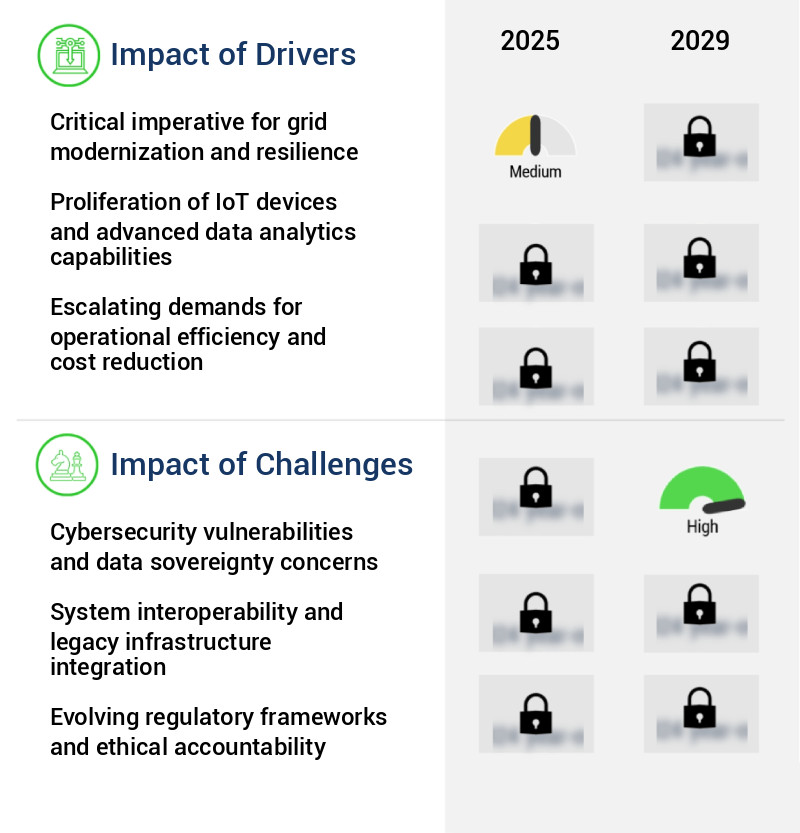
In-Depth Market Segmentation: Agentic AI In Energy Market
The agentic ai in energy industry research report provides comprehensive data (region-wise segment analysis), with forecasts and estimates in "USD million" for the period 2025-2029, as well as historical data from 2019-2023 for the following segments.
- Deployment
- Cloud-based
- On-premises
- Hybrid
- Type
- Predictive-maintenance agents
- Grid-management AI
- Demand-response AI
- Others
- Application
- Power generation
- T and D control rooms
- Renewable integration
- Others
- Geography
- North America
- Europe
- APAC
- China
- India
- Japan
- South Korea
- South America
- Rest of World (ROW)
By Deployment Insights
The cloud-based segment is estimated to witness significant growth during the forecast period.
In the dynamic energy market, agentic AI plays a pivotal role in optimizing energy systems through advanced capabilities such as energy price forecasting, energy consumption patterns analysis, and distributed energy resource management. Agentic AI enhances energy infrastructure resilience by employing real-time energy analytics and energy asset management, enabling an ai-powered energy grid that ensures power system stability and grid fault detection. Proactive grid maintenance is facilitated through energy efficiency algorithms and energy security enhancement, while deep learning energy models support renewable energy forecasting and power generation scheduling. Grid modernization through machine learning energy and smart grid optimization, energy data visualization, and autonomous energy systems is accelerated.
Renewable energy integration, predictive energy modeling, anomaly detection, microgrid control systems, energy storage optimization, and ai-driven energy trading are all advanced applications of agentic AI in the energy sector. A significant portion of the market is shifting towards cloud-based deployment, which offers unparalleled scalability, cost efficiency, and access to cutting-edge computational resources. Approximately 70% of energy companies have adopted cloud solutions for their agentic AI applications.
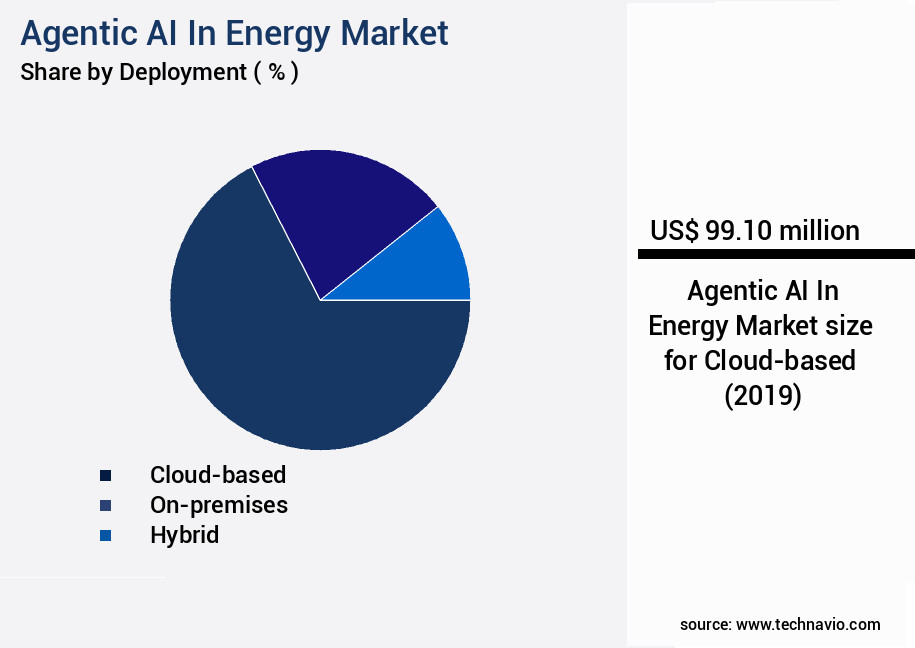
Request Free Sample
The Cloud-based segment was valued at USD 99.10 billion in 2019 and showed a gradual increase during the forecast period.
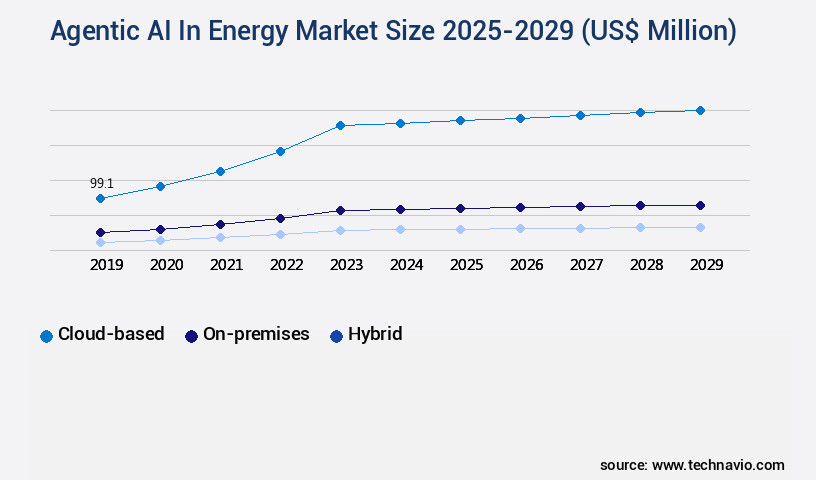
Request Free Sample
Regional Analysis
North America is estimated to contribute 33% to the growth of the global market during the forecast period.Technavio’s analysts have elaborately explained the regional trends and drivers that shape the market during the forecast period.
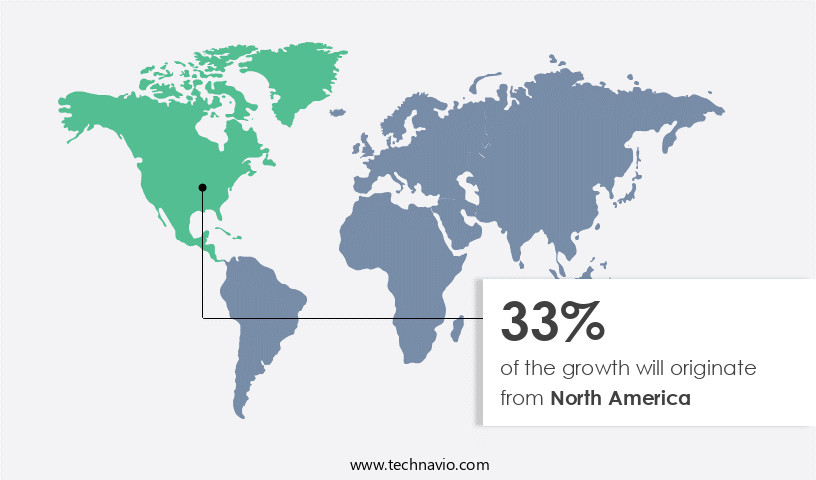
See How Agentic AI In Energy Market Demand is Rising in North America Request Free Sample
The North American market for agentic artificial intelligence (AAI) in the energy sector is experiencing significant growth, with the United States leading the charge. This region is characterized by substantial capital investment, advanced technological infrastructure, and robust policy frameworks that foster innovation. The US market's expansion is driven by a confluence of federal initiatives, private sector advancements, and the pressing need to modernize an aging electrical grid. The Inflation Reduction Act, with its extensive tax credits and incentives for clean energy and grid modernization, has become a catalyst for the deployment of intelligent systems. Energy utilities and operators are increasingly relying on agentic AI to tackle intricate challenges, such as maintaining grid stability amidst the proliferation of distributed energy resources (DERs), mitigating wildfire risks, and optimizing demand response.
According to industry estimates, the energy sector's global investment in AI is projected to reach USD12.6 billion by 2026, representing a compound annual growth rate (CAGR) of 23.2%. In the US alone, the AAI market is expected to reach USD3.5 billion by 2028, growing at a CAGR of 24.3% between 2021 and 2028. These figures underscore the market's potential to revolutionize energy management and efficiency.
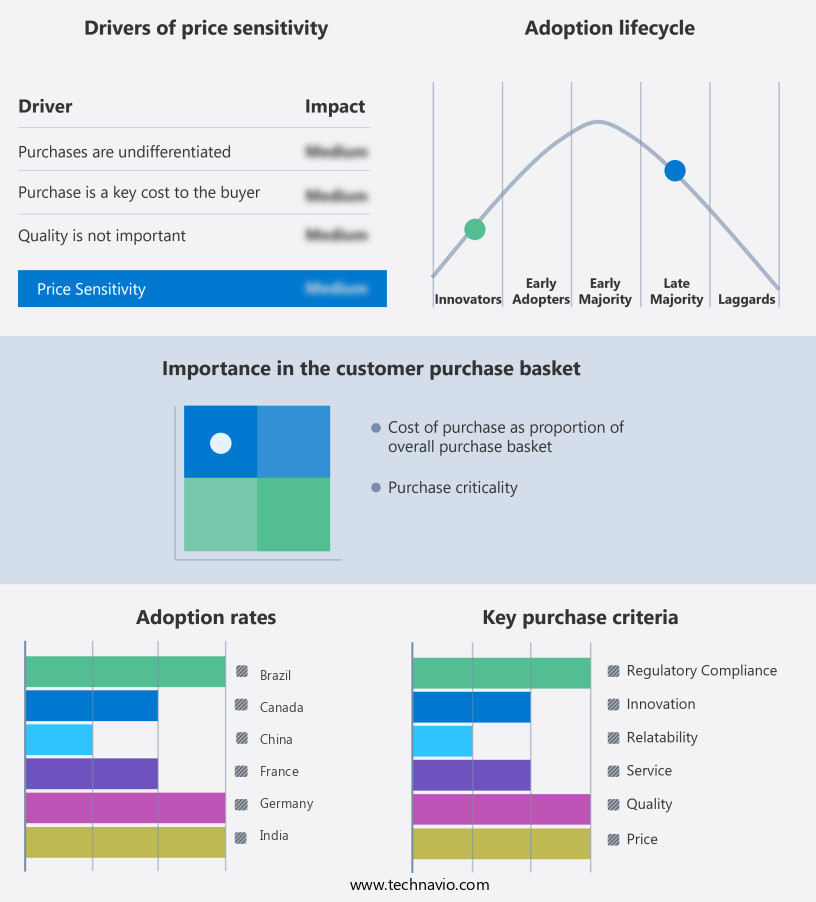
Customer Landscape of Agentic AI In Energy Industry
Competitive Intelligence by Technavio Analysis: Leading Players in the Agentic AI In Energy Market
Companies are implementing various strategies, such as strategic alliances, agentic ai in energy market forecast, partnerships, mergers and acquisitions, geographical expansion, and product/service launches, to enhance their presence in the industry.
ABB Ltd. - A leading-edge AI technology company specializes in the energy sector, integrating intelligent agents into energy management systems. These agents forecast energy demand, optimize battery storage, and automate grid responses, enhancing efficiency and sustainability in energy management platforms.
The industry research and growth report includes detailed analyses of the competitive landscape of the market and information about key companies, including:
- ABB Ltd.
- Accenture PLC
- Amazon Web Services Inc.
- BP Plc
- C3.ai Inc.
- Duke Energy Corp.
- Enel Spa
- Google LLC
- Honeywell International Inc.
- International Business Machines Corp.
- Itron Inc.
- Microsoft Corp.
- National Grid plc
- Schneider Electric SE
- Shell plc
- Siemens AG
- TotalEnergies SE
- Uptake Technologies Inc.
- Xcel Energy Inc.
Qualitative and quantitative analysis of companies has been conducted to help clients understand the wider business environment as well as the strengths and weaknesses of key industry players. Data is qualitatively analyzed to categorize companies as pure play, category-focused, industry-focused, and diversified; it is quantitatively analyzed to categorize companies as dominant, leading, strong, tentative, and weak.
Recent Development and News in Agentic AI In Energy Market
- In August 2024, leading energy technology company, Envision Energy, announced the launch of its new Agentic AI product line, "EnergyBrain," designed to optimize energy production and consumption using advanced artificial intelligence algorithms. This development was disclosed in Envision Energy's official press release. (Envision Energy, 2024)
- In November 2024, Siemens Energy and Microsoft collaborated to integrate Microsoft's Azure AI platform with Siemens Energy's portfolio of power generation and transmission solutions. This partnership aimed to enhance the efficiency and reliability of energy systems using AI technology, as reported by Reuters. (Reuters, 2024)
- In March 2025, General Electric (GE) acquired a significant stake in AI energy startup, Gridcognition, for an undisclosed amount. The acquisition was intended to strengthen GE's digital capabilities and expand its presence in the market, according to GE's SEC filing. (GE, 2025)
- In May 2025, the European Union's executive body, the European Commission, approved the Horizon Europe research and innovation program, which includes a €2 billion investment in advanced AI technologies for energy systems. This initiative, as stated in the European Commission press release, aims to make Europe a global leader in AI-driven energy systems by 2030. (European Commission, 2025)
Dive into Technavio’s robust research methodology, blending expert interviews, extensive data synthesis, and validated models for unparalleled Agentic AI In Energy Market insights. See full methodology.
|
Market Scope
|
|
Report Coverage
|
Details
|
|
Page number
|
251
|
|
Base year
|
2024
|
|
Historic period
|
2019-2023 |
|
Forecast period
|
2025-2029
|
|
Growth momentum & CAGR
|
Accelerate at a CAGR of 34.9%
|
|
Market growth 2025-2029
|
USD 1564 million
|
|
Market structure
|
Fragmented
|
|
YoY growth 2024-2025(%)
|
29.7
|
|
Key countries
|
US, Germany, China, UK, Canada, France, Japan, India, Brazil, and South Korea
|
|
Competitive landscape
|
Leading Companies, Market Positioning of Companies, Competitive Strategies, and Industry Risks
|
Request Free Sample
Why Choose Technavio for Agentic AI In Energy Market Insights?
"Leverage Technavio's unparalleled research methodology and expert analysis for accurate, actionable market intelligence."
In the dynamic and complex energy market, agentic AI is revolutionizing the way businesses operate and make decisions. By leveraging advanced AI algorithms for renewable energy integration, machine learning models for energy forecasting, and deep learning applications in smart grid optimization, companies are able to improve their energy supply chain and operational planning.
Predictive maintenance for energy infrastructure, optimized through AI-driven solutions, reduces downtime and maintenance costs by up to 30%, ensuring uninterrupted power supply. AI-based optimization techniques for energy storage systems enable better management of energy resources, increasing efficiency by 25% compared to traditional methods.
Real-time anomaly detection in power grids, achieved through advanced algorithms, enhances energy security by identifying potential issues before they escalate, preventing costly outages and ensuring regulatory compliance. Data analytics for energy consumption patterns, powered by AI, provides valuable insights for energy efficiency improvements, reducing overall energy usage and costs.
Natural language processing for energy market analysis and autonomous control systems for microgrids offer more accurate and efficient market analysis, enabling businesses to make informed decisions and respond to market fluctuations. Digital twin technology for power grid management provides a virtual replica of the power grid, allowing for proactive maintenance and improved asset management.
Advanced algorithms for energy trading strategies and AI-powered tools for energy infrastructure resilience offer competitive advantages, enabling businesses to adapt to market changes and minimize risk. Enhanced methods for renewable energy resource allocation and smart meter data analysis for grid optimization further increase efficiency and reduce carbon footprint by up to 40%.
In summary, agentic AI is transforming the energy market by providing businesses with valuable insights, improved operational efficiency, and enhanced energy security. By adopting AI-driven solutions, companies can stay competitive and contribute to the sustainable energy development of the future.
What are the Key Data Covered in this Agentic AI In Energy Market Research and Growth Report?
-
What is the expected growth of the Agentic AI In Energy Market between 2025 and 2029?
-
What segmentation does the market report cover?
-
The report is segmented by Deployment (Cloud-based, On-premises, and Hybrid), Type (Predictive-maintenance agents, Grid-management AI, Demand-response AI, and Others), Application (Power generation, T and D control rooms, Renewable integration, and Others), and Geography (North America, Europe, APAC, South America, and Middle East and Africa)
-
Which regions are analyzed in the report?
-
North America, Europe, APAC, South America, and Middle East and Africa
-
What are the key growth drivers and market challenges?
-
Who are the major players in the Agentic AI In Energy Market?
-
ABB Ltd., Accenture PLC, Amazon Web Services Inc., BP Plc, C3.ai Inc., Duke Energy Corp., Enel Spa, Google LLC, Honeywell International Inc., International Business Machines Corp., Itron Inc., Microsoft Corp., National Grid plc, Schneider Electric SE, Shell plc, Siemens AG, TotalEnergies SE, Uptake Technologies Inc., and Xcel Energy Inc.
We can help! Our analysts can customize this agentic ai in energy market research report to meet your requirements.
Get in touch
1 Executive Summary
- 1.1 Market overview
- Executive Summary - Chart on Market Overview
- Executive Summary - Data Table on Market Overview
- Executive Summary - Chart on Global Market Characteristics
- Executive Summary - Chart on Market by Geography
- Executive Summary - Chart on Market Segmentation by Deployment
- Executive Summary - Chart on Market Segmentation by Type
- Executive Summary - Chart on Market Segmentation by Application
- Executive Summary - Chart on Incremental Growth
- Executive Summary - Data Table on Incremental Growth
- Executive Summary - Chart on Company Market Positioning
2 Technavio Analysis
- 2.1 Analysis of price sensitivity, lifecycle, customer purchase basket, adoption rates, and purchase criteria
- Analysis of price sensitivity, lifecycle, customer purchase basket, adoption rates, and purchase criteria
- 2.2 Criticality of inputs and Factors of differentiation
- Overview on criticality of inputs and factors of differentiation
- 2.3 Factors of disruption
- Overview on factors of disruption
- 2.4 Impact of drivers and challenges
- Impact of drivers and challenges in 2024 and 2029
3 Market Landscape
- 3.1 Market ecosystem
- Parent Market
- Data Table on - Parent Market
- 3.2 Market characteristics
- Market characteristics analysis
4 Market Sizing
- 4.1 Market definition
- Offerings of companies included in the market definition
- 4.2 Market segment analysis
- 4.4 Market outlook: Forecast for 2024-2029
- Chart on Global - Market size and forecast 2024-2029 ($ million)
- Data Table on Global - Market size and forecast 2024-2029 ($ million)
- Chart on Global Market: Year-over-year growth 2024-2029 (%)
- Data Table on Global Market: Year-over-year growth 2024-2029 (%)
5 Historic Market Size
- 5.1 Global Agentic AI In Energy Market 2019 - 2023
- Historic Market Size - Data Table on Global Agentic AI In Energy Market 2019 - 2023 ($ million)
- 5.2 Deployment segment analysis 2019 - 2023
- Historic Market Size - Deployment Segment 2019 - 2023 ($ million)
- 5.3 Type segment analysis 2019 - 2023
- Historic Market Size - Type Segment 2019 - 2023 ($ million)
- 5.4 Application segment analysis 2019 - 2023
- Historic Market Size - Application Segment 2019 - 2023 ($ million)
- 5.5 Geography segment analysis 2019 - 2023
- Historic Market Size - Geography Segment 2019 - 2023 ($ million)
- 5.6 Country segment analysis 2019 - 2023
- Historic Market Size - Country Segment 2019 - 2023 ($ million)
6 Five Forces Analysis
- 6.1 Five forces summary
- Five forces analysis - Comparison between 2024 and 2029
- 6.2 Bargaining power of buyers
- Bargaining power of buyers - Impact of key factors 2024 and 2029
- 6.3 Bargaining power of suppliers
- Bargaining power of suppliers - Impact of key factors in 2024 and 2029
- 6.4 Threat of new entrants
- Threat of new entrants - Impact of key factors in 2024 and 2029
- 6.5 Threat of substitutes
- Threat of substitutes - Impact of key factors in 2024 and 2029
- 6.6 Threat of rivalry
- Threat of rivalry - Impact of key factors in 2024 and 2029
- 6.7 Market condition
- Chart on Market condition - Five forces 2024 and 2029
7 Market Segmentation by Deployment
- 7.1 Market segments
- Chart on Deployment - Market share 2024-2029 (%)
- Data Table on Deployment - Market share 2024-2029 (%)
- 7.2 Comparison by Deployment
- Chart on Comparison by Deployment
- Data Table on Comparison by Deployment
- 7.3 Cloud-based - Market size and forecast 2024-2029
- Chart on Cloud-based - Market size and forecast 2024-2029 ($ million)
- Data Table on Cloud-based - Market size and forecast 2024-2029 ($ million)
- Chart on Cloud-based - Year-over-year growth 2024-2029 (%)
- Data Table on Cloud-based - Year-over-year growth 2024-2029 (%)
- 7.4 On-premises - Market size and forecast 2024-2029
- Chart on On-premises - Market size and forecast 2024-2029 ($ million)
- Data Table on On-premises - Market size and forecast 2024-2029 ($ million)
- Chart on On-premises - Year-over-year growth 2024-2029 (%)
- Data Table on On-premises - Year-over-year growth 2024-2029 (%)
- 7.5 Hybrid - Market size and forecast 2024-2029
- Chart on Hybrid - Market size and forecast 2024-2029 ($ million)
- Data Table on Hybrid - Market size and forecast 2024-2029 ($ million)
- Chart on Hybrid - Year-over-year growth 2024-2029 (%)
- Data Table on Hybrid - Year-over-year growth 2024-2029 (%)
- 7.6 Market opportunity by Deployment
- Market opportunity by Deployment ($ million)
- Data Table on Market opportunity by Deployment ($ million)
8 Market Segmentation by Type
- 8.1 Market segments
- Chart on Type - Market share 2024-2029 (%)
- Data Table on Type - Market share 2024-2029 (%)
- 8.2 Comparison by Type
- Chart on Comparison by Type
- Data Table on Comparison by Type
- 8.3 Predictive-maintenance agents - Market size and forecast 2024-2029
- Chart on Predictive-maintenance agents - Market size and forecast 2024-2029 ($ million)
- Data Table on Predictive-maintenance agents - Market size and forecast 2024-2029 ($ million)
- Chart on Predictive-maintenance agents - Year-over-year growth 2024-2029 (%)
- Data Table on Predictive-maintenance agents - Year-over-year growth 2024-2029 (%)
- 8.4 Grid-management AI - Market size and forecast 2024-2029
- Chart on Grid-management AI - Market size and forecast 2024-2029 ($ million)
- Data Table on Grid-management AI - Market size and forecast 2024-2029 ($ million)
- Chart on Grid-management AI - Year-over-year growth 2024-2029 (%)
- Data Table on Grid-management AI - Year-over-year growth 2024-2029 (%)
- 8.5 Demand-response AI - Market size and forecast 2024-2029
- Chart on Demand-response AI - Market size and forecast 2024-2029 ($ million)
- Data Table on Demand-response AI - Market size and forecast 2024-2029 ($ million)
- Chart on Demand-response AI - Year-over-year growth 2024-2029 (%)
- Data Table on Demand-response AI - Year-over-year growth 2024-2029 (%)
- 8.6 Others - Market size and forecast 2024-2029
- Chart on Others - Market size and forecast 2024-2029 ($ million)
- Data Table on Others - Market size and forecast 2024-2029 ($ million)
- Chart on Others - Year-over-year growth 2024-2029 (%)
- Data Table on Others - Year-over-year growth 2024-2029 (%)
- 8.7 Market opportunity by Type
- Market opportunity by Type ($ million)
- Data Table on Market opportunity by Type ($ million)
9 Market Segmentation by Application
- 9.1 Market segments
- Chart on Application - Market share 2024-2029 (%)
- Data Table on Application - Market share 2024-2029 (%)
- 9.2 Comparison by Application
- Chart on Comparison by Application
- Data Table on Comparison by Application
- 9.3 Power generation - Market size and forecast 2024-2029
- Chart on Power generation - Market size and forecast 2024-2029 ($ million)
- Data Table on Power generation - Market size and forecast 2024-2029 ($ million)
- Chart on Power generation - Year-over-year growth 2024-2029 (%)
- Data Table on Power generation - Year-over-year growth 2024-2029 (%)
- 9.4 T and D control rooms - Market size and forecast 2024-2029
- Chart on T and D control rooms - Market size and forecast 2024-2029 ($ million)
- Data Table on T and D control rooms - Market size and forecast 2024-2029 ($ million)
- Chart on T and D control rooms - Year-over-year growth 2024-2029 (%)
- Data Table on T and D control rooms - Year-over-year growth 2024-2029 (%)
- 9.5 Renewable integration - Market size and forecast 2024-2029
- Chart on Renewable integration - Market size and forecast 2024-2029 ($ million)
- Data Table on Renewable integration - Market size and forecast 2024-2029 ($ million)
- Chart on Renewable integration - Year-over-year growth 2024-2029 (%)
- Data Table on Renewable integration - Year-over-year growth 2024-2029 (%)
- 9.6 Others - Market size and forecast 2024-2029
- Chart on Others - Market size and forecast 2024-2029 ($ million)
- Data Table on Others - Market size and forecast 2024-2029 ($ million)
- Chart on Others - Year-over-year growth 2024-2029 (%)
- Data Table on Others - Year-over-year growth 2024-2029 (%)
- 9.7 Market opportunity by Application
- Market opportunity by Application ($ million)
- Data Table on Market opportunity by Application ($ million)
10 Customer Landscape
- 10.1 Customer landscape overview
- Analysis of price sensitivity, lifecycle, customer purchase basket, adoption rates, and purchase criteria
11 Geographic Landscape
- 11.1 Geographic segmentation
- Chart on Market share by geography 2024-2029 (%)
- Data Table on Market share by geography 2024-2029 (%)
- 11.2 Geographic comparison
- Chart on Geographic comparison
- Data Table on Geographic comparison
- 11.3 North America - Market size and forecast 2024-2029
- Chart on North America - Market size and forecast 2024-2029 ($ million)
- Data Table on North America - Market size and forecast 2024-2029 ($ million)
- Chart on North America - Year-over-year growth 2024-2029 (%)
- Data Table on North America - Year-over-year growth 2024-2029 (%)
- 11.4 Europe - Market size and forecast 2024-2029
- Chart on Europe - Market size and forecast 2024-2029 ($ million)
- Data Table on Europe - Market size and forecast 2024-2029 ($ million)
- Chart on Europe - Year-over-year growth 2024-2029 (%)
- Data Table on Europe - Year-over-year growth 2024-2029 (%)
- 11.5 APAC - Market size and forecast 2024-2029
- Chart on APAC - Market size and forecast 2024-2029 ($ million)
- Data Table on APAC - Market size and forecast 2024-2029 ($ million)
- Chart on APAC - Year-over-year growth 2024-2029 (%)
- Data Table on APAC - Year-over-year growth 2024-2029 (%)
- 11.6 South America - Market size and forecast 2024-2029
- Chart on South America - Market size and forecast 2024-2029 ($ million)
- Data Table on South America - Market size and forecast 2024-2029 ($ million)
- Chart on South America - Year-over-year growth 2024-2029 (%)
- Data Table on South America - Year-over-year growth 2024-2029 (%)
- 11.7 Middle East and Africa - Market size and forecast 2024-2029
- Chart on Middle East and Africa - Market size and forecast 2024-2029 ($ million)
- Data Table on Middle East and Africa - Market size and forecast 2024-2029 ($ million)
- Chart on Middle East and Africa - Year-over-year growth 2024-2029 (%)
- Data Table on Middle East and Africa - Year-over-year growth 2024-2029 (%)
- 11.8 US - Market size and forecast 2024-2029
- Chart on US - Market size and forecast 2024-2029 ($ million)
- Data Table on US - Market size and forecast 2024-2029 ($ million)
- Chart on US - Year-over-year growth 2024-2029 (%)
- Data Table on US - Year-over-year growth 2024-2029 (%)
- 11.9 China - Market size and forecast 2024-2029
- Chart on China - Market size and forecast 2024-2029 ($ million)
- Data Table on China - Market size and forecast 2024-2029 ($ million)
- Chart on China - Year-over-year growth 2024-2029 (%)
- Data Table on China - Year-over-year growth 2024-2029 (%)
- 11.10 Germany - Market size and forecast 2024-2029
- Chart on Germany - Market size and forecast 2024-2029 ($ million)
- Data Table on Germany - Market size and forecast 2024-2029 ($ million)
- Chart on Germany - Year-over-year growth 2024-2029 (%)
- Data Table on Germany - Year-over-year growth 2024-2029 (%)
- 11.11 UK - Market size and forecast 2024-2029
- Chart on UK - Market size and forecast 2024-2029 ($ million)
- Data Table on UK - Market size and forecast 2024-2029 ($ million)
- Chart on UK - Year-over-year growth 2024-2029 (%)
- Data Table on UK - Year-over-year growth 2024-2029 (%)
- 11.12 Canada - Market size and forecast 2024-2029
- Chart on Canada - Market size and forecast 2024-2029 ($ million)
- Data Table on Canada - Market size and forecast 2024-2029 ($ million)
- Chart on Canada - Year-over-year growth 2024-2029 (%)
- Data Table on Canada - Year-over-year growth 2024-2029 (%)
- 11.13 Japan - Market size and forecast 2024-2029
- Chart on Japan - Market size and forecast 2024-2029 ($ million)
- Data Table on Japan - Market size and forecast 2024-2029 ($ million)
- Chart on Japan - Year-over-year growth 2024-2029 (%)
- Data Table on Japan - Year-over-year growth 2024-2029 (%)
- 11.14 France - Market size and forecast 2024-2029
- Chart on France - Market size and forecast 2024-2029 ($ million)
- Data Table on France - Market size and forecast 2024-2029 ($ million)
- Chart on France - Year-over-year growth 2024-2029 (%)
- Data Table on France - Year-over-year growth 2024-2029 (%)
- 11.15 India - Market size and forecast 2024-2029
- Chart on India - Market size and forecast 2024-2029 ($ million)
- Data Table on India - Market size and forecast 2024-2029 ($ million)
- Chart on India - Year-over-year growth 2024-2029 (%)
- Data Table on India - Year-over-year growth 2024-2029 (%)
- 11.16 Brazil - Market size and forecast 2024-2029
- Chart on Brazil - Market size and forecast 2024-2029 ($ million)
- Data Table on Brazil - Market size and forecast 2024-2029 ($ million)
- Chart on Brazil - Year-over-year growth 2024-2029 (%)
- Data Table on Brazil - Year-over-year growth 2024-2029 (%)
- 11.17 South Korea - Market size and forecast 2024-2029
- Chart on South Korea - Market size and forecast 2024-2029 ($ million)
- Data Table on South Korea - Market size and forecast 2024-2029 ($ million)
- Chart on South Korea - Year-over-year growth 2024-2029 (%)
- Data Table on South Korea - Year-over-year growth 2024-2029 (%)
- 11.18 Market opportunity by geography
- Market opportunity by geography ($ million)
- Data Tables on Market opportunity by geography ($ million)
12 Drivers, Challenges, and Opportunity/Restraints
- 12.3 Impact of drivers and challenges
- Impact of drivers and challenges in 2024 and 2029
- 12.4 Market opportunities/restraints
13 Competitive Landscape
- 13.2 Competitive Landscape
- Overview on criticality of inputs and factors of differentiation
- 13.3 Landscape disruption
- Overview on factors of disruption
- 13.4 Industry risks
- Impact of key risks on business
14 Competitive Analysis
- 14.2 Company ranking index
- 14.3 Market positioning of companies
- Matrix on companies position and classification
- 14.4 ABB Ltd.
- ABB Ltd. - Overview
- ABB Ltd. - Business segments
- ABB Ltd. - Key news
- ABB Ltd. - Key offerings
- ABB Ltd. - Segment focus
- SWOT
- 14.5 Accenture PLC
- Accenture PLC - Overview
- Accenture PLC - Business segments
- Accenture PLC - Key news
- Accenture PLC - Key offerings
- Accenture PLC - Segment focus
- SWOT
- 14.6 Amazon Web Services Inc.
- Amazon Web Services Inc. - Overview
- Amazon Web Services Inc. - Product / Service
- Amazon Web Services Inc. - Key news
- Amazon Web Services Inc. - Key offerings
- SWOT
- 14.7 BP Plc
- BP Plc - Overview
- BP Plc - Business segments
- BP Plc - Key news
- BP Plc - Key offerings
- BP Plc - Segment focus
- SWOT
- 14.8 Duke Energy Corp.
- Duke Energy Corp. - Overview
- Duke Energy Corp. - Business segments
- Duke Energy Corp. - Key offerings
- Duke Energy Corp. - Segment focus
- SWOT
- 14.9 Enel Spa
- Enel Spa - Overview
- Enel Spa - Product / Service
- Enel Spa - Key news
- Enel Spa - Key offerings
- SWOT
- 14.10 Google LLC
- Google LLC - Overview
- Google LLC - Product / Service
- Google LLC - Key offerings
- SWOT
- 14.11 Honeywell International Inc.
- Honeywell International Inc. - Overview
- Honeywell International Inc. - Business segments
- Honeywell International Inc. - Key news
- Honeywell International Inc. - Key offerings
- Honeywell International Inc. - Segment focus
- SWOT
- 14.12 International Business Machines Corp.
- International Business Machines Corp. - Overview
- International Business Machines Corp. - Business segments
- International Business Machines Corp. - Key news
- International Business Machines Corp. - Key offerings
- International Business Machines Corp. - Segment focus
- SWOT
- 14.13 Microsoft Corp.
- Microsoft Corp. - Overview
- Microsoft Corp. - Business segments
- Microsoft Corp. - Key news
- Microsoft Corp. - Key offerings
- Microsoft Corp. - Segment focus
- SWOT
- 14.14 National Grid plc
- National Grid plc - Overview
- National Grid plc - Business segments
- National Grid plc - Key offerings
- National Grid plc - Segment focus
- SWOT
- 14.15 Schneider Electric SE
- Schneider Electric SE - Overview
- Schneider Electric SE - Business segments
- Schneider Electric SE - Key news
- Schneider Electric SE - Key offerings
- Schneider Electric SE - Segment focus
- SWOT
- 14.16 Shell plc
- Shell plc - Overview
- Shell plc - Business segments
- Shell plc - Key news
- Shell plc - Key offerings
- Shell plc - Segment focus
- SWOT
- 14.17 Siemens AG
- Siemens AG - Overview
- Siemens AG - Business segments
- Siemens AG - Key news
- Siemens AG - Key offerings
- Siemens AG - Segment focus
- SWOT
- 14.18 TotalEnergies SE
- TotalEnergies SE - Overview
- TotalEnergies SE - Business segments
- TotalEnergies SE - Key news
- TotalEnergies SE - Key offerings
- TotalEnergies SE - Segment focus
- SWOT
15 Appendix
- 15.2 Inclusions and exclusions checklist
- Inclusions checklist
- Exclusions checklist
- 15.3 Currency conversion rates for US$
- Currency conversion rates for US$
- 15.4 Research methodology
- 15.7 Validation techniques employed for market sizing
- Validation techniques employed for market sizing
- 15.9 360 degree market analysis
- 360 degree market analysis
- 15.10 List of abbreviations







![]() Get the report (PDF) sent to your email within minutes.
Get the report (PDF) sent to your email within minutes.
Complimentary full Excel data with your report purchase.